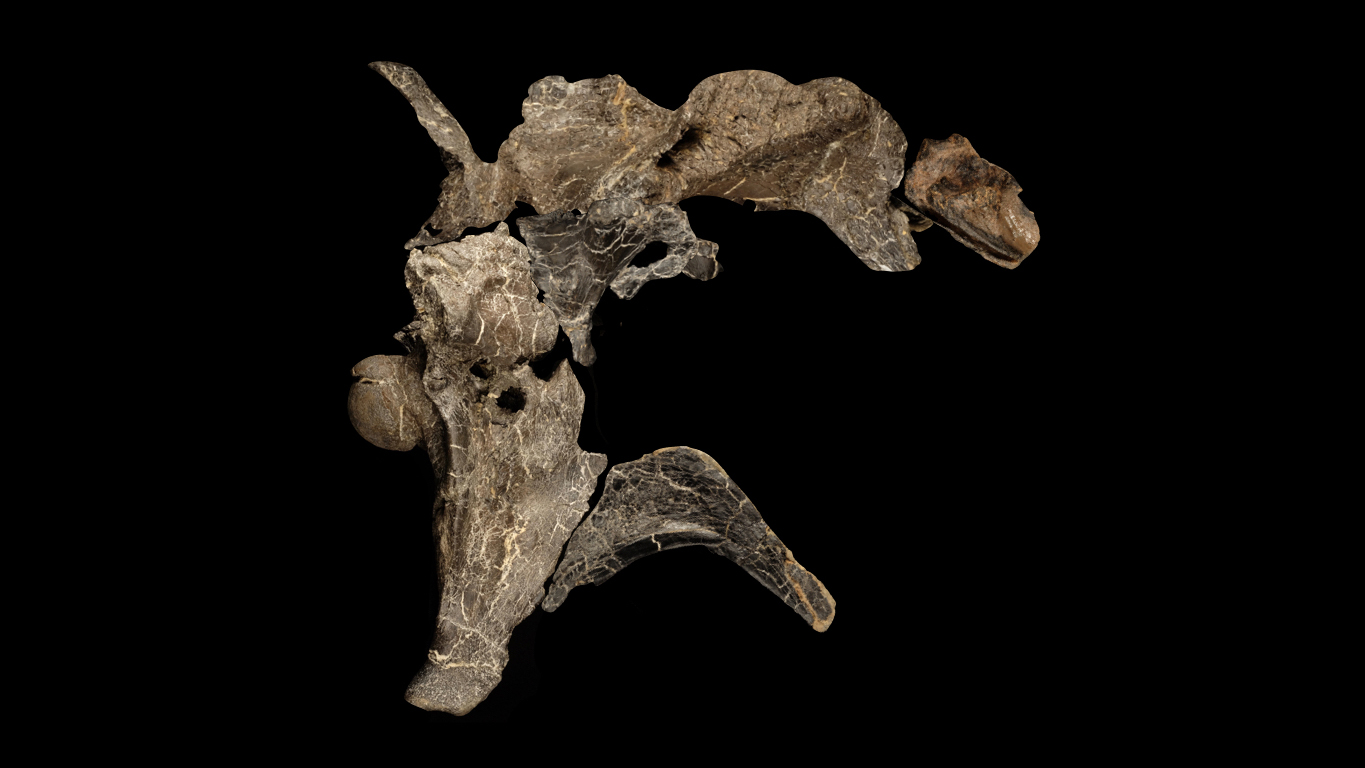'Crocodile-faced hell heron' dinosaur discovered in England

Two toothy carnivorous dinosaurs with crocodile-type skulls once stalked the riverbanks on England's Isle of Wight, new fossils reveal.
Scientists gave the creatures scientific names that translate to "horned, crocodile-faced hell heron" and "riverbank hunter." The predators are early species of spinosaurids, relatives of the weird, possibly amphibious Spinosaurus, which was bigger than Tyrannosaurus rex and had a large sail on its back.
The two new species sported the elongated, crocodile-like skull much like Spinosaurus, but there's no evidence for similar sails. Ceratosuchops inferodios, the newly discovered "hell heron," is known from just a few skull fragments, while the "riverbank hunter" Riparovenator milnerae, named in honor of late British paleontologist Angela Milner, is known from pieces of skull and some tailbones. Previously, only one type of spinosaurid had been found in the United Kingdom: an impressively clawed hunter known as Baryonyx.
"We've known for a couple of decades now that Baryonyx-like dinosaurs awaited discovery on the Isle of Wight, but finding the remains of two such animals in close succession was a huge surprise," study co-author Darren Naish, an independent British paleontologist, said in a statement. Naish also wrote about the findings on his blog, Tet Zoo.
Diversity of predators
Though the two new species are known from just a few bones, the bone fragments discovered were very telling, as they included the braincases and teeth of the dinosaurs. The braincase contains a lot of anatomical clues for identifying different species, including the placement of nerves and muscle attachments. C. inferodios sported a lumpy forehead with low horns and bumps.
"We found the skulls to differ not only from Baryonyx, but also one another, suggesting the UK housed a greater diversity of spinosaurids than previously thought," Chris Barker, a doctoral student at the University of Southampton and the lead author of the study, said in the statement.

The two new species lived about 125 million years ago, in the early Cretaceous period — about 25 million years earlier than the dramatic, sail-sporting Spinosaurus. They likely stalked the waterways of an ancient floodplain, acting a bit like very large, toothy herons. They probably snapped up fish and terrestrial prey using their jaws, which were well suited to this style of hunting. Both species likely grew to about 29.5 feet (9 meters) long, based on the size of their skulls (3.3 feet, or 1 m). The two species' differing skull shapes suggest they could have had slightly different hunting styles, which may have allowed Baryonyx, C. inferodios, and R. milnerae to find plenty of food in a shared landscape.
Sign up for the Live Science daily newsletter now
Get the world’s most fascinating discoveries delivered straight to your inbox.
"It might sound odd to have two similar and closely related carnivores in an ecosystem, but this is actually very common for both dinosaurs and numerous living ecosystems," study co-author David Hone, a senior lecturer and director of biological sciences programs at Queen Mary University of London, said in the statement.
Spinosaurid family tree
The history and evolution of the spinosaurid family is a bit controversial; in fact, researchers don't even agree on whether the late Cretaceous Spinosaurus waded like a heron or swam like a crocodile. But the new discovery suggests that this group of dinosaurs may have first evolved in what is today Europe before spreading to Asia and the supercontinent Gondwana, which later split into Africa and South America, the researchers wrote Wednesday (Sept. 29) in the journal Nature Communications.
The researchers attempted to build a family tree, which puts the new spinosaurids in a separate branch (the baryonychines, for the taxonomy lovers) that split from the branch that gave rise to Spinosaurus (the spinosaurines) about 145 million years ago.
"There's still a lot to learn — the almost total absence of Jurassic spinosaurid taxa [groups] remains a problem! — but, for now, it looks as if the group originated in Europe, then spread to Asia and Africa," Naish wrote on Tet Zoo. "The presence of both baryonychines and spinosaurines in Africa indicates separate migration events for these clades."
The researchers are now working on a more detailed paper about R. milnerae's tail, Naish wrote. The tail bones suggest a tall, flat tail, similar to the shape seen on modern-day caimen. They also plan to further explore the relationships among the different spinosaurid relatives worldwide.
Originally published on Live Science.

Stephanie Pappas is a contributing writer for Live Science, covering topics ranging from geoscience to archaeology to the human brain and behavior. She was previously a senior writer for Live Science but is now a freelancer based in Denver, Colorado, and regularly contributes to Scientific American and The Monitor, the monthly magazine of the American Psychological Association. Stephanie received a bachelor's degree in psychology from the University of South Carolina and a graduate certificate in science communication from the University of California, Santa Cruz.










